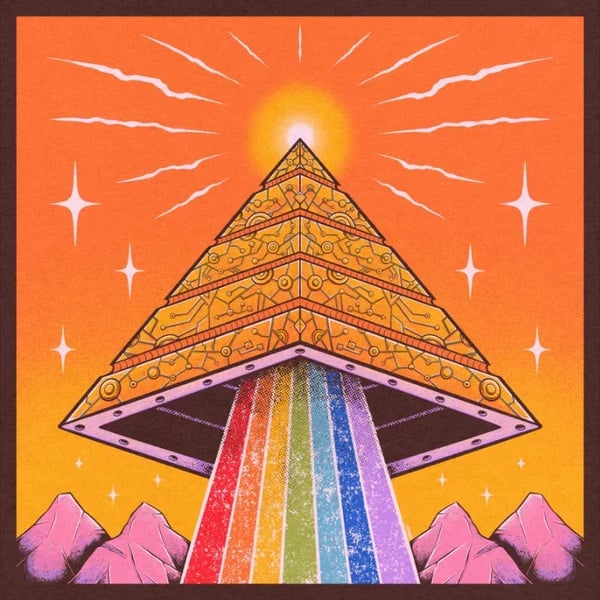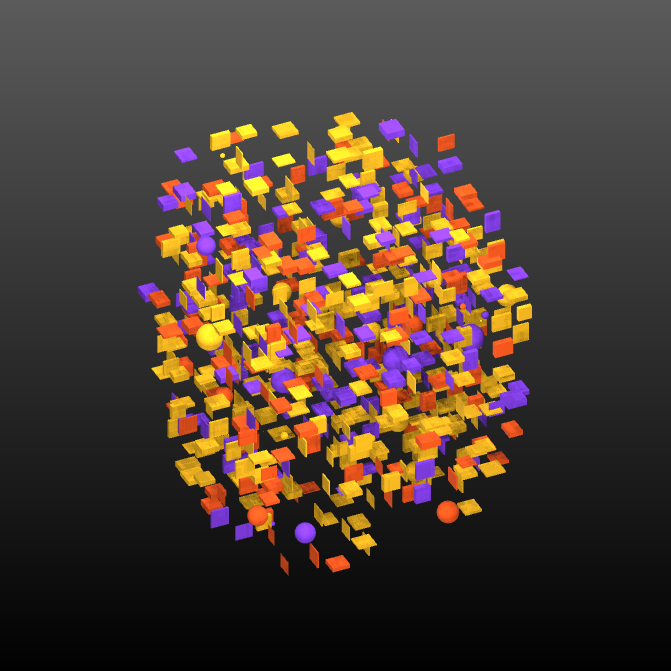Digitising physical artwork and inscribing it on Bitcoin offers a unique permanence that differentiates it significantly to the ephemeral nature of traditional art. By inscribing it on-chain, artists ensure their work is preserved somewhat indefinitely, accessible worldwide, and immune to damage or loss. This process not only extends the artwork's reach but also secures its authenticity and legacy in a way that physical mediums cannot.
Let’s meet some Gamma Partner Artists who create entirely physically, and then bring that work to the digital world through scanning and other methods.
Zoe Louise
On bringing her physical work to the digital world, for Zoe Louise, this shift has not only transformed the way she creates and shares her work, but it has also changed her relationship with her art in profound ways.
Zoe explains that converting her physical artwork into a digital form brings a certain sense of finality: “It creates a sense of permanence, a feeling of no ctrl Z. This step is one I have never gone back on to tweak physically. It either worked or it didn't.” By making this transition, her relationship with each piece evolves—becoming more mature, less controlled, and ultimately leading to “a place of appreciation and reflection” that exists outside of herself.
Her exploration into digital collectibles was sparked by the limitations of physical formats. The idea that she could present the same piece in its intended form to audiences around the world, at the same time, was a revelation. “The digital setting lends itself to storytelling,” Zoe shares. In this new realm, every element of the artwork's narrative—titles, descriptions, collections, timestamps, and conversations—becomes available to anyone, at any moment. As she puts it, “You can see the whole book, not just one or three pages.”
However, the transition from physical to digital is not without its challenges. Preserving the essence of her work in the digital form requires careful consideration of specific elements. “Colours play an integral part in the success of this,” she notes, emphasizing that size also plays a significant role in determining whether a piece can make the transition successfully. “Some make it, some don't,” she acknowledges, demonstrating her selective approach to the digital medium.
Despite the differences in format, Zoe sees her physical and digital artworks as separate yet deeply interconnected. "They couldn’t exist without each other," she remarks, highlighting the inherent link between the two. And for collectors who engage with her digital art, Zoe believes they gain something unique: “They gain a known interaction with the story.” This interaction allows for a deeper connection to the art's narrative, something distinct from owning a physical piece.
The shift to digital also raises questions about authenticity, originality, and ownership, especially in the context of art being preserved on Bitcoin. While Zoe’s views on authenticity and originality remain unchanged—“whether you are these things or not, the only person it impacts is yourself”—she believes that the full effects of digital ownership are still unfolding, with much left to understand.
For artists contemplating their first steps into the digital realm, Zoe offers this advice: “Don’t get too caught up in the technical. If the feeling translates through the screen, you're onto something special.”
Her journey from the physical to the digital underscores the evolving nature of art in the modern age, where storytelling, interaction, and preservation are taking on new forms and meanings. Through it all, Zoe Louise remains committed to ensuring that the emotion and essence of her work resonate—whether on canvas or screen.

Tami Rienzi
When it comes to the digitisation process for artist Tami Rienzi, transforming her physical artwork into digital formats doesn’t fundamentally change her relationship with the piece. She maintains a deep connection to her art, whether it exists in the physical world or as a digital collectible. “I love my pieces in all their forms and textures; both the physical and digital realms have their own magic,” Tami reflects. However, digitizing her art brings an added layer of meaning. “I feel a sense of relief when I digitize my art because by inscribing it on the blockchain, I’m creating a legacy—a statement from my older self to future generations. It can never be destroyed.”
Her exploration into digital collectibles was inspired by her vision for the future of art. She believes that many people have yet to fully grasp the possibilities. “It’s the future of art, people don’t realize that yet,” she states. Digital art, to Tami, offers unparalleled accessibility, and the fact that it is spread across millions of nodes worldwide is something she finds truly astounding.
When it comes to ensuring that the texture, details, and essence of her physical pieces are preserved in the digital form, Tami relies on the tools available on Gamma. “I use the Gamma platform,” she shares, noting that her initial attempts to use other resources didn’t yield the best results—likely due to inexperience, as she humorously points out. Still, her dedication to translating her art into digital form has clearly paid off, with the blockchain providing a new way for her creations to be experienced.
Tami views her physical and digital artworks as deeply interconnected. In her practice, “the physical is the mother of the inscriptions,” she explains, indicating that her physical pieces often serve as the foundation for her digital creations. This connection between the two formats highlights the evolving relationship between traditional art and its digital counterparts.
For collectors who purchase digital versions of her art, Tami believes they gain something unique and enduring: “When you collect my digital art, you get something that lasts forever on the blockchain—no fading, no damage, just pure art preserved digitally. It is always accessible no matter where you are.” This permanence is one of the major benefits of digital art, offering a sense of security and preservation that traditional formats simply can’t match.
The shift to creating digital art, particularly using the Bitcoin blockchain, has also influenced Tami’s views on concepts like authenticity, originality, and ownership. “By inscribing my artworks as ordinals, every piece gets a unique ID that lives forever on the blockchain—like a digital DNA,” she says. This permanence and traceability mean her work will always be linked to her, creating a legacy that transcends the physical. In this way, her art isn’t just an object she’s created, but a lasting statement that can’t be altered or lost over time.
For artists looking to make the leap into digital formats, Tami offers simple but valuable advice: “Just start!!! The first ones will not be perfect, you will make mistakes, but as you keep doing it, you will improve.” She likens the process to running—“your first laps will be very slow, but as time goes by, your times will keep on improving. Consistency is the key.”
Tami Rienzi’s journey from physical to digital art showcases the transformative potential of blockchain technology in the art world, where permanence, accessibility, and legacy are redefined in exciting new ways.

Schwonk
When bringing work to Bitcoin for Schwonk, the transformation of physical artwork into digital formats is a fluid process that varies depending on where the artwork is in its creative journey. Sometimes, digitizing a piece is the final stage, such as photographing or scanning it for social media, prints, or NFTs.
In those moments, Schwonk describes the digital transition as “a satisfying final step solidifying that the painting is finished.” However, when the digital stage happens in the middle of the creative process, it becomes an additional tool. “I will start with an idea or a photo, then move on to sketching with pencil or pen and ink. After the initial sketch and rough composition, I either go right to the canvas or digitize it and play around with digital tools before bringing it back to the analogue painting process,” Schwonk explains. This blending of methods allows for flexibility and the freedom to experiment both digitally and physically.
Schwonk’s inspiration to explore digital collectibles is deeply rooted in their love for Bitcoin. The immutability of the Bitcoin blockchain sparked the idea of using it as a permanent digital certificate of authenticity for physical works. “I liked that idea,” Schwonk says. But as they delved deeper into Bitcoin’s potential, they realized that these digital inscriptions could exist as collectables independent of the physical work. “I don’t think it’s an either-or kind of thing,” Schwonk reflects, “the digital can exist in relationship with the physical thing or not. I like it the most when these things exist together and have a relationship to one another.” For Schwonk, digital collectibles open new pathways for both artists and collectors, complementing rather than replacing traditional formats.
Capturing the texture, details, and essence of a physical artwork in digital form requires a careful approach, and Schwonk has developed a reliable method for achieving this. “I use indirect diffused natural outdoor light, and a high megapixel digital camera on a tripod. This usually does a great job of capturing the texture, details, and essence of the piece,” Schwonk explains. This method ensures that the richness of the original artwork is preserved when it’s translated into a digital format.
When it comes to viewing their digital and physical works, Schwonk sees both as interconnected but flexible. “Both, just depends,” they say, indicating that the relationship between the two formats can vary depending on the piece and the context in which it’s shared.
For collectors, owning a digital version of Schwonk’s art offers its own unique advantages. “They can put it in their pocket. It can be animated. It can be easily traded,” Schwonk points out. Yet, despite these benefits, Schwonk feels that physical art still holds a certain superiority: “Physical is superior in most every other way,” they admit, suggesting that while digital art offers convenience and versatility, there’s something irreplaceable about owning a tangible piece.
The shift to creating digital versions of artwork has broadened Schwonk’s views on topics like authenticity, originality, and ownership, especially when it comes to preserving art on Bitcoin. “It has expanded and broadened my horizons on the subject,” Schwonk shares, reflecting a growing appreciation for the possibilities digital art offers.
For artists looking to translate their physical works into digital formats for the first time, Schwonk’s advice is simple but practical: “Get good images of your physical work. Put it into Squoosh app and play around with the file sizes. I use AVIF files.” This technical insight offers a straightforward approach to ensuring quality digital representations of physical pieces, helping other artists navigate the early stages of the digital transition.

Arno Carstens
Arno Carstens, a celebrated painter and musician, has been at the forefront of this evolution, bridging the gap between traditional and digital mediums.
When asked how transforming his physical artwork into a digital format changes his relationship with the piece, Arno reflected, "I get to do what former generations couldn’t as a painter, which makes me feel incredibly grateful. This transformation allows my works to live in two realms — the physical and the digital, enhancing their accessibility and the way they're experienced on a global scale." The ability to preserve and present physical artwork digitally opens doors to new audiences and experiences, enriching both the artist’s and the viewer’s engagement with the work.
Arno’s journey into digital collectibles began in 2021 after a conversation with an artist friend. "My manager and I began researching NFTs and quickly found Stacks because we knew we wanted something anchored to Bitcoin. Initially, there were no Ordinals, so I began with Stacks. Once Ordinals launched in early 2023, I started inscribing my art there," he explained. He emphasized how the digital art scene fosters interactivity, particularly through platforms like Twitter Spaces, which enable richer, more engaged community experiences. "It’s fantastic for those looking to explore and diversify their collections," he added.
Translating physical art into digital form requires careful consideration of how to preserve the texture, details, and essence of a piece. Arno and his team prioritize high-quality photography to capture maximum detail. "Although some fidelity is inevitably lost when transitioning from oil on canvas to digital formats, especially Bitcoin Ordinals, we select artworks that translate well digitally to minimize this effect," he shared. This meticulous approach ensures the integrity of the artwork is maintained in its digital representation.
For Arno, the relationship between his physical and digital artworks is deeply interconnected. "They are interconnected parts of my larger body of work, which includes even my music. I’m currently exploring ways to integrate this with live exhibitions and performances, creating a holistic artistic experience that spans multiple mediums," he revealed. This interconnectedness highlights the potential for blending different forms of artistic expression into immersive experiences.
Digital art also offers collectors unique advantages. "Collectors of my digital art gain access to a new form of engagement and presentation. Digital artworks are versatile in display and sharing, offering an immersive experience that traditional formats can’t match. Bitcoin ensures the provenance and authenticity of each piece, which is a significant advantage for collectors looking for secure, verifiable ownership," Arno explained. These benefits are reshaping how ownership and provenance are perceived in the modern art market.
The shift to digital has also expanded Arno’s perspective on concepts like authenticity, originality, and ownership. "This shift has truly expanded my view on what authenticity and originality mean today. With each piece being verifiable through Bitcoin, the notion of ownership and provenance are clearer than ever. It’s fascinating to think about how these concepts are evolving in the digital age, with digital art offering a permanent, unalterable form of artistic expression that’s preserved for generations," he reflected.
For artists looking to transition their physical works into digital formats, Arno offers encouraging advice: "Start now, and don't be afraid to join in on this burst of creativity. Everyone is still learning, and it’s really exciting to be part of the early stages of a brand new era of art’s evolution. Platforms like YouTube and Twitter are fantastic for learning the basics and finding your community. Remember, transitioning to digital doesn’t detract from the importance of your original creations; it merely extends their reach and introduces your work to a broader audience."
Arno Carstens exemplifies how artists can embrace the digital frontier while honoring their traditional roots, paving the way for a new era of creative expression. His journey demonstrates the boundless possibilities of blending physical and digital mediums, offering inspiration for those ready to explore this evolving landscape.





